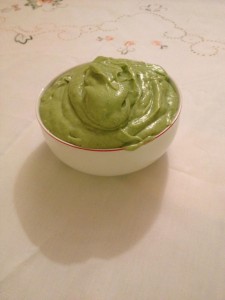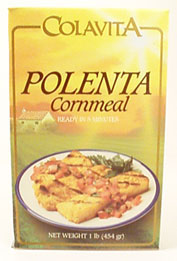
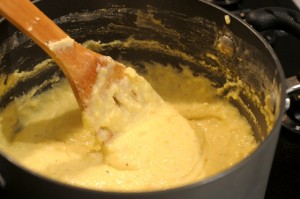
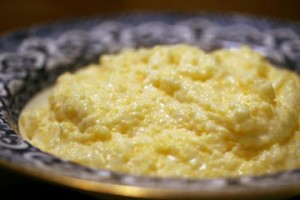
Polenta is the Italian name for stone-ground corn, but it’s also known as cornmeal mush or grits and is a basic grain in many cultures. It’s milled corn kernels that can be cooked into porridge or baked, or fried. An excellent, delicious recipe for people with swallowing disorders or anyone else who loves to eat. There’s really not any modification needed for this recipe: if the polenta seems too thick, add some more butter or stir in a dollop of cream.
Here are the basic ingredients for Polenta
6 cups water
2 teaspoons salt
1 3/4 cups yellow cornmeal
3 tablespoons unsalted butter
Directions
Bring 6 cups of water to a boil in a heavy large saucepan. Add 2 teaspoons of salt. Gradually whisk in the cornmeal. Marcella Hazen, the famous Italian cookbook writer says the following: “turn the heat down to medium low so that the water is just simmering, and add the cornmeal in a very thin stream, stirring with a stout, long wooden spoon The stream of cornmeal must be so thin that you can see the individual grains, A good way to do it is to let a fistful of cornmeal run through nearly closed fingers. Never stop stirring, and keep the water at a slow, steady simmer” [Marcella Hazen, The Classic Italian Cookbook]. Cook very slowly until the mixture thickens and the cornmeal is tender, stirring often, about 30 to 45 minutes. The polenta is done when it tears away from the sides of the pot as you stir.Then turn off the heat. Add the butter, and stir until melted.
Read more at: http://www.foodnetwork.com/recipes/giada-de-laurentiis/basic-polenta-recipe/index.html?oc=linkback
You can make polenta with water only as in the recipe above, but it’s a little richer and creamier if you add 1/2 cup of milk to the recipe so there’s 6 ½ cups of liquid. I’d add more butter as well, vigorously stirred in along with ½ cup freshly grated Parmesan cheese
For polenta you’re serving right away, you want a consistency about as thick or sour cream.

Now comes the fun part. What do you put on top of the Polenta [not that it’s not perfectly delicious all by itself]? You could add poached or fried eggs (be sure you don’t have crispy edges; mix the eggs into the polenta so there’s no “runniness”, that is, nothing to drop into the airway ).
Or, add a thick tomato sauce.
Thick Tomato Sauce
3 tablespoons olive oil
½ cup finely diced onions
½ cup finely diced celery
½ cup finely diced carrots
2 cloves garlic, finely diced
1 large can (28 oz) Sclafani crushed tomatoes (preferred because they’re delicious & already thick)
2 tablespoons thick tomato paste
1 bouquet garni (1 teaspoon each of the following dried herbs: basil, oregano, thyme tied into a piece of washed cheese cloth; or use the same combination of fresh herbs, increasing the amount to 2 sprigs each)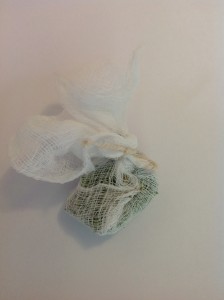
1. Heat the olive oil and add the onions and cook over low heat for 10 minutes until the onions are translucent.
2. Add the celery, onions, carrots and garlic and bouquet garni and continue to cook another 5-8 minutes until the celery & carrots are soft.
3. Add the tomatoes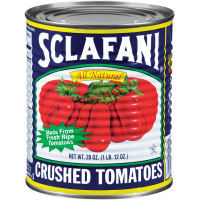 and bring to a simmer (bubbles just starting to pop up). Lower the heat and set the pot’s lid at an angle, and cook until the sauce is thick, about 30 minutes.
and bring to a simmer (bubbles just starting to pop up). Lower the heat and set the pot’s lid at an angle, and cook until the sauce is thick, about 30 minutes.
4. Add the tomato paste and cook an additional 10 minutes.
5. Remove the bouquet garni and then strain the sauce to remove any remaining bits of vegetables.
6. Put a helping of the polenta in a bowl and cover with a ½ cup of the tomato sauce.
You could also use the polenta to make a lasagna-like dish, substituting sliced polenta for lasagna noodles, layering with cheeses such as Pecorino Romano and Fontina or gruyere.
Joy the Baker, on her food blog (January 14, 2013), has a recipe for baked polenta. It’s pretty much the same recipe as above, but here you pour the ingredients except the butter into an 8 x 8 inch baking pan. Stir to combine (the polenta will sink to the bottom of the pan, she says, & the water will be cloudy) and bake for 45 minutes in a 350 degrees F oven. Remove from heat and add butter, bake again for 15 more minutes. The top may be crusty and you might want to remove it, before serving it, as she did, with the thickened tomato sauce.
